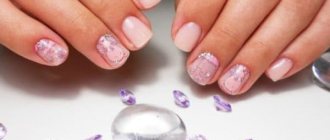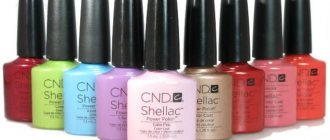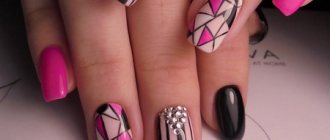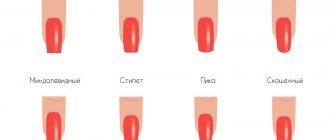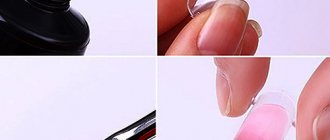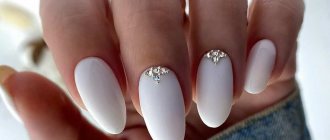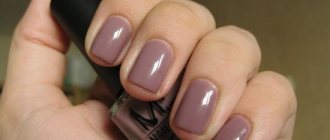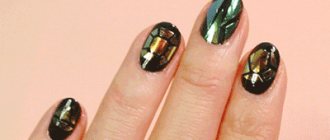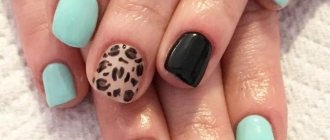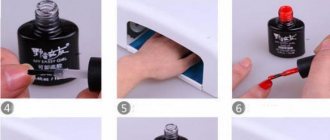Is it possible to paint extended nails?
Extended nails are another novelty in the nail industry, which most girls accepted with delight. Almost instantly transform your nails beyond recognition - they become long, with an interesting shape and original design. And which ones are practical - they last a long time, and there is no need to constantly take care of the coating - when to apply and remove. But a person quickly gets bored with everything, and the design that admired a week ago is no longer pleasing.
What to do? There is an answer - it turns out that you can apply gel polish with a completely different fashionable design to your extended nails. But is everything so easy and simple, will gel polish harm the extended nails?
Is it possible to paint extended nails - Malinka
March 2, 2012| Yana|
Is it possible to paint extended nails?
Extensions are a great opportunity to have a beautiful manicure without putting any effort into it, except for the monetary costs of the work of the master. But you always want variety and you get tired of walking with the same type of surface after 5-7 days. Is it possible to paint extended nails? We will dot all the i's.
There are two types of extensions:
- Acrylic. There is more scope for creating three-dimensional drawings here. However, using acrylic has some disadvantages - a specific smell and the possibility of allergies.
- Gel. Most secure. In addition, gel-extended nails have a beautiful, intense shine. The disadvantages include fragility. If the gel nail breaks, you will have to file it down and build a new one. Acrylic in the same situation can be easily adjusted.
How to properly paint extended nails?
Let's make a reservation right away - you can paint the extended coating. This will not harm the texture, shape, or color in any way, but, on the contrary, will give the manicure a more well-groomed and interesting look.
However, there are some nuances:
- Many cheap varnishes turn natural nails yellow, and can also give an undesirable tint to the extended coating. But! This is only if you don't apply a base. Apply clear varnish as the very first layer and there will be no problems. Acrylic absorbs pigments most intensely.
- You can paint your nails with regular varnish, or make shellac, glue rhinestones, or make drawings. There is an opinion that varnishes last much longer on extended nails than on natural nails.
You can remove polish from extended nails only with liquids without acetone. Acrylic in contact with acetone may acquire a yellowish tint. Gel nails also cannot tolerate this substance. Using it may make their surface slightly rough. It is best to use nail polish remover that specifically states that it is for extended nails. If this is not the case, then any non-acetone oil-based product will do.
Taking care of extended nails is not difficult. It is recommended to wear gloves for housework, such as cleaning or washing dishes. And of course, do not hesitate to get advice on care from your master. You can remove acrylic nails yourself at home, but gel extensions can be filed off at a salon.
Tags: nail extensions
Post navigation
Secrets of great design
Let's talk about some of the features and nuances of this process:
- Don’t forget right away - shake the bottle of gel polish to ensure uniformity of the composition;
- Note that basically the technique of applying gel polish on your own and extended nails is the same;
- Please note that the coating must be applied to artificial nails in a dense, thin layer, otherwise this coating will look unnatural and bulky. The reason is that if you extend your nails with gel polish, they will be thicker than natural ones, and if you apply a thick coating, it will be too much;
- We carefully study the label and annotations. If the gel polish forms a sticky (dispersive) layer after drying (polymerization) in a UV lamp, it must be removed, for example, with a lint-free, smooth cloth. It is harmful and can even cause an allergic reaction;
- If you also get tired of gel polish, removing it from artificial nails is not so easy - you cannot, for example, use acetone (it will eat the extended nails themselves, they are also made of gel). It is also not advisable to remove it with a file; removers or a router with attachments are suitable here.
Fresh shellac nail design ideas
Shellac manicure is one of the most popular coatings. Millions of women around the world choose it for its durability and the ability to use many additional decorative elements. Shellac nail design is the choice of modern and stylish women.
Wedding (ceremonial) nail design with shellac
Made with shellac is an excellent solution that will allow you to save a lot of time. You can safely do it a few days before the celebration and not worry that your fingers will look sloppy and not aesthetically pleasing. That is why, dear brides and fashionistas, we offer you several options for wedding manicure, which are also perfect for any special evening.
Option 1. Shellac - French lace manicure.
This design can rightfully be called classic. It is performed for weddings, birthdays, New Year and many other holidays. However, a wedding wedding made with shellac will be distinguished by its luxury and solemnity. Complete the classic white French manicure with thin lace (also made with white varnish) carefully placed on all nails.
Option 2.
The first thing you must remember is that you should not overload a shellac manicure on short nails with an abundance of jewelry. Delicate tones or colors to match the dress will suit you like nothing else. Perform a manicure in white or beige shades, place several small rhinestones or sparkles on the ring finger on the nail.
Option 3. Wedding manicure with roses
A wedding manicure made with shellac and complemented by an image of roses looks very gentle and unusual. This nail design is suitable for romantic and gentle natures. Cover the nail with a light pink shade, and along the edge of the nail, draw miniature roses in white or red.
Option 4. Wedding manicure in gold color
It looks very unusual and elegant, made in gold color. Shellac coating will achieve a glossy effect, which will add luxury and elegance to the image. Cover your nails with white polish, then paint the top half with a gold design or flowers. This design does not require additional decorations, as it looks very solemn in itself.
Option 5. Wedding moon manicure
Wedding lunar manicure has been occupying a leading position for several years now. With this manicure, the bottom hole of the nail is highlighted, the top is shaped as desired.
Do the same manicure on all fingers, leave the oval area at the bottom empty or paint it with a different color. Contrasting with the main one. This design does not require additional decorations, so designs, as a rule, are not made on the nails in a lunar manicure.
Casual nail design with shellac
Plain color will never go out of style. That is why we offer you this option as one of the most popular designs for everyday use. Use bright colors or muted ones, depending on where you are going today or where you work.
Also, do not give up on bright patterns or delicate lace images; thanks to its texture, shellac nail design allows you to create real works of art on your nails.
In the cold season, rich dark shades of shellac are relevant, in the warm season (spring, summer, early autumn) - delicate pastels or, on the contrary, bright, flashy ones.
Shellac coating has remained relevant for several years. Create your own style and manicure using current and fashionable shades of varnish - bright red, warm taupe, emerald, pink cedar, mustard, lilac-violet.
Option 1. Nail design with shellac and glitter
Cover your nails with a single color polish. Select glitter of different diameters, 1-2 shades darker than the main color, but in the same color palette. Apply glitter to the free edge of the nail.
Option 2. Contrast
This shellac manicure is suitable even for short nails. Choose a neutral base and apply it all over your nails. Next, apply a leopard print pattern to one or two nails.
Option 3. Triangles
Shellac is applied in two layers, the first layer is the color you want the triangles to be. For example red or blue. Apply the first layer, seal the triangle, and cover the nail with the second layer – the base.
Option 4. Creative splashes
This design is ideal for creative and cheerful people. Apply light-colored polish to all nails. Next, use a brush to make random strokes or splashes of multi-colored polishes on your nails. That's all. An unusual, but at the same time very interesting manicure is ready!
We told you how easy and interesting it is to combine shellac coating with nail art and decorative elements. But you can create interesting nail designs with shellac not only from specialists, but also on your own at home. All you need to do is purchase the necessary equipment and take courses. Of course, this pleasure is not cheap, but once you receive all the necessary knowledge, you will become a real professional. In this case, you will be able to delight not only yourself, but also your friends with bright and beautiful nails, creating real works of art.
Shellac has been a leader in manicure coatings for several years now. For its many positive characteristics, it received the approval and recognition of not only ordinary girls and women, but also nail service masters of the highest level.
Gel polish or shellac opens up enormous possibilities for creating a beautiful and durable manicure. But to create an unusual design, you want to use all the means possible. You will learn how gel-based and traditional products are combined in our article.
How to do this without errors
Let's look at the technology of applying gel polish on artificial gel nails step by step:
- You should not wash or steam your nails; they will absorb excess moisture, which will affect the quality of the coating. It is enough to soften and push back the cuticles and side ridges;
- polishing stage. Using a special file for extended nails (buff), you need to ideally polish the surface of the artificial nail; the quality of the coating layers depends on this;
- degreasing of extended nails with a primer, unlike natural ones, is not necessary according to some experts; others insist on this stage;
- applying the base (foundation). It not only protects natural nails from chemical attack, but also improves the adhesion of the layers. That is why it is recommended to apply the base to extended nails. It only takes about two minutes to polymerize;
- main point. Apply gel polish to extended nails using neat, long strokes from the cuticle to the cut, in a thin layer, without touching the skin. We seal the edge for beautiful contours and polymerize in a UV lamp;
- if the color is not very saturated, you can apply a second thin layer of color and dry it in a lamp;
- You need to secure the work by applying the last layer - the finishing layer (top), dry it for 2 minutes in a lamp and admire the extended nails covered with gel polish until the next correction;
- removal of harmful dispersion - a sticky layer, particles of which can lead to allergies;
- The last stage will last a long time - this is regular nail care.
Important. To protect the new coating of extended nails with gel polish, it is recommended to wear gloves for the first two to three days while doing housework.
Features and recommendations for applying gel polish on extended nails
The procedure and technique for applying gel coating to artificial nails is not much different from the standard procedure, but there are some nuances that need to be taken into account.
Just like when covering natural nails with gel polish, you need to first shake the bottle with the product so that the pigment is mixed.
To make the manicure aesthetically pleasing, gel polish should be applied to extended nails in as thin a layer as possible. The fact is that a gel nail is much thicker than a natural one, and 2-3 dense layers of gel polish are unlikely to add grace and aesthetics.
When you're tired of everything
If the desire to change the design is great, then the process of removing gel polish will not scare you. It’s already been said above that you can’t remove it with acetone, or with a file, just to rip it off is even more barbaric. Is there anything else I can do to remove gel polish from extended nails?
A few recommendations on this issue:
- removal with remover. The solvents are gentle and contain vitamins and minerals. The method is fast, effective, safe;
- removal using a special device (milling cutter) with different attachments (cutters). In the experienced hands of a specialist, this is a quick, effective procedure. You can learn how to use a router at home and remove gel polish easily, without discomfort, saving on salon services;
- the third method is not very useful for nails. But if there is nothing else to remove the gel polish with, you can use alcohol diluted with water (1:1) or 100% vodka as a solvent. The exposure time should be increased to 20-30 minutes.
Care and care
Some tips for caring for your nails after such procedures:
- nails made of fragile gel material cannot be used as a household tool;
- professionals recommend resting the nail plates and cuticles after removing the coating;
- You can strengthen and nourish your nails by applying a special fortified clear varnish;
- After removing gel polish, you cannot do without baths, wraps and masks, which contain vitamins, healthy acids and oils, and minerals.
Fashion trends
And at the end - a surprise. Let's reveal the secret - what 2018 will bring to the world of beauty and nail design:
- shape of the year - almond, medium-length oval. The color of the year is beige, black, but not only. Example – painting, roses on a black oval;
- The delightful South Korean novelty stunned me - a manicure with a gold wire border is always in trend;
- “glass” manicure, reminiscent of broken glass (that’s what they call it) or the facets of a diamond;
- a fashionable matte manicure decorated with a glossy pattern, for example, a drop, a pea, a leaf, a strip, is at the peak of popularity this year;
- Chameleon polish is still in trend. This is a thermovarnish that constantly changes shades - depending on the temperature of the air, the hand, and the lighting. This opens up some fantastic options for playing with color;
- artistic painting of nails is now applied to the very edges of them, and the subject of painting can be flowers, hieroglyphs, geometric patterns;
- drawing on stone is a fashionable novelty. Agate, malachite, turquoise, onyx, magical drawings - who can resist here.
Is it possible to paint extended nails?
What happens if you paint your extended nails? - this question worries many girls who have had their nails done in a salon. The design made on extended nails by a master soon becomes boring; you want something new and fresh.
Nail extensions have become fashionable not so long ago. For many, this procedure is not just a tribute to fashion trends, but also convenience: there is no need to suffer and grow your nails, if you can simply extend them and then remove them, if desired.
Most often, nails are extended either with acrylic or gel. Each of these types of nails requires special care. The fact that after the extension procedure you need to use gloves during housework and make regular corrections is clear to everyone. Is it possible to varnish extended nails without spoiling their appearance?
Yes, you can. Only here there are rules. For example, for gel nails you can choose any varnish you like, but the liquid to remove it should not contain acetone. Acetone makes gel nails feel rough to the touch and can quickly deteriorate. Therefore, to remove polish from gel nails, it is better to buy oil or another product that does not contain acetone.
The same applies to acrylic nails. You can paint them with any varnish, but there are several nuances. Extended nails need to be prepared for polish. This is done like this: first you need to file your nails, clean them, apply a base, and then cover them with a layer of varnish and fix the effect. A base coat is needed to ensure that the varnish does not eat into the artificial nail and change its color.
Almost the same thing is done with “native” nails during manicure. The advantage is that if ordinary nails “hold” a manicure for two to three days, then extended nails painted with varnish will please the eye for at least two weeks.
Extended nails manicured in the “craquelure” style will look very impressive. For this nail design you will need a special varnish - crack, a base and a varnish fixer.
There are two options for creating nail art with “cracks”. First: apply both base and varnish, and then draw cracks with a special stick or thin needle. But this takes a lot of time and effort if you have no experience in this technique.
Suitable for acrylic and gel nails and sand effect varnishes. They can be applied in the same way as on regular nails.
Therefore, another method is preferable: buy a varnish that will “crack” itself as it dries on your nails. To make the effect even stronger, a similar varnish - krake - can be applied in several layers. Just don’t forget about the harmonious color scheme that should end up on your nails during your next experiment.
If you don’t want to paint with varnish, then acrylic-based paints will come to the rescue in nail art for artificial nails.
Unlike traditional varnishes, paints do not crack or chip; they are easy to wash off with water if suddenly some stroke or the color of the paint itself is not suitable. In addition, such paints are not harmful to health.
How to paint extended nails with acrylic paints? It's not that difficult. It is important to have everything you need for complete nail art: brushes of different sizes, rhinestones, stickers, base coat for artificial nails,
Before you paint acrylic or gel nails, you need to carefully think about what kind of picture you want to get in the end. The fact is that acrylic paints differ from each other in terms of their pigment saturation and are divided into four categories: transparent, translucent, viscous and opaque. To try out a variety of options, you can dilute paints of different categories with water and mix them together.
There are special techniques for designing acrylic nails. For example, watercolor assumes that it is the drawing that will stand out against the general background. Before applying it to the nail, the plate must be primed. After the primer layer has dried, paint is taken and a picture is drawn on the nail. The resulting result is fixed with colorless varnish.
What happens if you paint your extended nails? - this question worries many girls who have had their nails done in a salon. The design made on extended nails by a master soon becomes boring; you want something new and fresh.
Nail extensions have become fashionable not so long ago. For many, this procedure is not just a tribute to fashion trends, but also convenience: there is no need to suffer and grow your nails, if you can simply extend them and then remove them, if desired.
Most often, nails are extended either with acrylic or gel. Each of these types of nails requires special care. The fact that after the extension procedure you need to use gloves during housework and make regular corrections is clear to everyone. Is it possible to varnish extended nails without spoiling their appearance?
Yes, you can. Only here there are rules. For example, for gel nails you can choose any varnish you like, but the liquid to remove it should not contain acetone. Acetone makes gel nails feel rough to the touch and can quickly deteriorate. Therefore, to remove polish from gel nails, it is better to buy oil or another product that does not contain acetone.
The same applies to acrylic nails. You can paint them with any varnish, but there are several nuances. Extended nails need to be prepared for polish. This is done like this: first you need to file your nails, clean them, apply a base, and then cover them with a layer of varnish and fix the effect. A base coat is needed to ensure that the varnish does not eat into the artificial nail and change its color.
Almost the same thing is done with “native” nails during manicure. The advantage is that if ordinary nails “hold” a manicure for two to three days, then extended nails painted with varnish will please the eye for at least two weeks.
Extended nails manicured in the “craquelure” style will look very impressive. For this nail design you will need a special varnish - crack, a base and a varnish fixer.
There are two options for creating nail art with “cracks”. First: apply both base and varnish, and then draw cracks with a special stick or thin needle. But this takes a lot of time and effort if you have no experience in this technique.
Suitable for acrylic and gel nails and sand effect varnishes. They can be applied in the same way as on regular nails.
Therefore, another method is preferable: buy a varnish that will “crack” itself as it dries on your nails. To make the effect even stronger, a similar varnish - krake - can be applied in several layers. Just don’t forget about the harmonious color scheme that should end up on your nails during your next experiment.
If you don’t want to paint with varnish, then acrylic-based paints will come to the rescue in nail art for artificial nails.
Unlike traditional varnishes, paints do not crack or chip; they are easy to wash off with water if suddenly some stroke or the color of the paint itself is not suitable. In addition, such paints are not harmful to health.
How to paint extended nails with acrylic paints? It's not that difficult. It is important to have everything you need for complete nail art: brushes of different sizes, rhinestones, stickers, base coat for artificial nails,
Before you paint acrylic or gel nails, you need to carefully think about what kind of picture you want to get in the end. The fact is that acrylic paints differ from each other in terms of their pigment saturation and are divided into four categories: transparent, translucent, viscous and opaque. To try out a variety of options, you can dilute paints of different categories with water and mix them together.
There are special techniques for designing acrylic nails. For example, watercolor assumes that it is the drawing that will stand out against the general background. Before applying it to the nail, the plate must be primed. After the primer layer has dried, paint is taken and a picture is drawn on the nail. The resulting result is fixed with colorless varnish.
There is also glazing, which you can do yourself is also not difficult. This technique is performed with pastel varnishes, which are applied layer by layer.
Painting extended nails is easy, but they also require maintenance. To ensure that acrylic or gel nails are always in good condition, you need to regularly make corrections in the salon, use only high-quality cuticle care products and do not use your nails as a screwdriver.
Also, experts do not recommend using varnishes if this happens after swimming. The varnish creates an impenetrable film under the nail, which can result in the formation of mold on the nail. Therefore, on the beach, it is better to paint your nails before diving into the sea or lake. This will avoid premature removal of artificial nails and fungal diseases of the nail plate.
The right choice of varnish, means for removing it and caring for extended nails will always allow you to create a beautiful and fashionable manicure.
You can and even need to paint your extended nails in order to keep up with fashion and experiment with nail designs. Both regular varnish and acrylic paints are suitable for this. But don’t forget about proper care for your extended nails.
Is it possible to paint extended nails with regular polish?
Is it possible to paint extended nails with varnish so as not to spoil their appearance? Since ancient times, fashionistas around the world have tried to decorate and give them the perfect shape. Now it is fashionable to build up and it has become available to everyone. Extended nails are very convenient and beautiful; you can extend them at any time, and remove them when you get tired of them. But time has passed and you are already tired of the design applied in the salon; you want something new.
How to properly paint extended nails?
Let's make a reservation right away - you can paint the extended coating. This will not harm the texture, shape, or color in any way, but, on the contrary, will give the manicure a more well-groomed and interesting look. However, there are some nuances: Many cheap varnishes turn natural nails yellow, and can also give an undesirable shade to the extended coating. But! This is only if you don't apply a base. Apply clear varnish as the very first layer and there will be no problems. Acrylic absorbs pigments most intensely. You can paint your nails with regular varnish, or make shellac, glue rhinestones, or make drawings. There is an opinion that varnishes last much longer on extended nails than on natural nails. You can remove polish from extended nails only with liquids without acetone. Acrylic in contact with acetone may acquire a yellowish tint. Gel nails also cannot tolerate this substance. Using it may make their surface slightly rough. It is best to use nail polish remover that specifically states that it is for extended nails. If this is not the case, then any non-acetone oil-based product will do. Taking care of extended nails is not difficult. It is recommended to wear gloves for housework, such as cleaning or washing dishes. And of course, do not hesitate to get advice on care from your master. You can remove acrylic nails yourself at home, but gel extensions can be filed off at a salon. What happens if you paint your extended nails? - this question worries many girls who have had their nails done in a salon. The design made on extended nails by a master soon becomes boring; you want something new and fresh. Nail extensions have become fashionable not so long ago. For many, this procedure is not just a tribute to fashion trends, but also convenience: there is no need to suffer and grow your nails, if you can simply extend them and then remove them, if desired. Most often, nails are extended either with acrylic or gel. Each of these types of nails requires special care. The fact that after the extension procedure you need to use gloves during housework and make regular corrections is clear to everyone. Is it possible to varnish extended nails without spoiling their appearance? Yes, you can. Only here there are rules. For example, for gel nails you can choose any varnish you like, but the liquid to remove it should not contain acetone. Acetone makes gel nails feel rough to the touch and can quickly deteriorate. Therefore, to remove polish from gel nails, it is better to buy oil or another product that does not contain acetone. The same applies to acrylic nails. You can paint them with any varnish, but there are several nuances. Extended nails need to be prepared for polish. This is done like this: first you need to file your nails, clean them, apply a base, and then cover them with a layer of varnish and fix the effect. A base coat is needed to ensure that the varnish does not eat into the artificial nail and change its color. Almost the same thing is done with “native” nails during manicure. The advantage is that if ordinary nails “hold” a manicure for two to three days, then extended nails painted with varnish will please the eye for at least two weeks. Extended nails manicured in the “craquelure” style will look very impressive. For this nail design you will need a special varnish - crack, a base and a varnish fixer. There are two options for creating nail art with “cracks”. First: apply both base and varnish, and then draw cracks with a special stick or thin needle. But this takes a lot of time and effort if you have no experience in this technique. Suitable for acrylic and gel nails and sand effect varnishes. They can be applied in the same way as on regular nails. Therefore, another method is preferable: buy a varnish that will “crack” itself as it dries on your nails. To make the effect even stronger, a similar varnish - krake - can be applied in several layers. Just don’t forget about the harmonious color scheme that should end up on your nails during your next experiment. If you don’t want to paint with varnish, then acrylic-based paints will come to the rescue in nail art for artificial nails. Unlike traditional varnishes, paints do not crack or chip; they are easy to wash off with water if suddenly some stroke or the color of the paint itself is not suitable. In addition, such paints are not harmful to health. How to paint extended nails with acrylic paints? It's not that difficult. It is important to have everything you need for full-fledged nail art: brushes of different sizes, rhinestones, stickers, base coat for artificial nails. Before painting acrylic or gel nails, you need to carefully think about what kind of picture you want to get in the end. The fact is that acrylic paints differ from each other in terms of their pigment saturation and are divided into four categories: transparent, translucent, viscous and opaque. To try out a variety of options, you can dilute paints of different categories with water and mix them together. There are special techniques for designing acrylic nails. For example, watercolor assumes that it is the drawing that will stand out against the general background. Before applying it to the nail, the plate must be primed. After the primer layer has dried, paint is taken and a picture is drawn on the nail. The resulting result is fixed with colorless varnish. There is also glazing, which you can do yourself is also not difficult. This technique is performed with pastel varnishes, which are applied layer by layer. Painting extended nails is easy, but they also require maintenance. To ensure that acrylic or gel nails are always in good condition, you need to regularly make corrections in the salon, use only high-quality cuticle care products and do not use your nails as a screwdriver. Also, experts do not recommend using varnishes if this happens after swimming. The varnish creates an impenetrable film under the nail, which can result in the formation of mold on the nail. Therefore, on the beach, it is better to paint your nails before diving into the sea or lake. This will avoid premature removal of artificial nails and fungal diseases of the nail plate. The right choice of varnish, means for removing it and caring for extended nails will always allow you to create a beautiful and fashionable manicure. You can and even need to paint your extended nails in order to keep up with fashion and experiment with nail designs. Both regular varnish and acrylic paints are suitable for this. But don’t forget about proper care for your extended nails. Is it possible to paint extended nails with varnish so as not to spoil their appearance? Since ancient times, fashionistas around the world have tried to decorate and give them the perfect shape. Now it is fashionable to build up and it has become available to everyone. Extended nails are very convenient and beautiful; you can extend them at any time, and remove them when you get tired of them. But time has passed and you are already tired of the design applied in the salon; you want something new.
Types of extended nails
There are gel and acrylic nail extensions.
- huge scope for creating three-dimensional drawings;
- elasticity and natural appearance;
- thin but very durable;
- resistant to temperature changes and bending;
- retain their natural shape without damaging the nail plate;
- can be easily adjusted and varnished;
- protects from environmental influences;
- specific smell;
- despite the fact that the coating protects, it prevents the nail from breathing;
- deterioration of shine, which can only be restored by sanding;
- possible allergy.
- easy to apply with a classic brush;
- dries quickly when exposed to ultraviolet rays;
- lasts a very long time (from one week to 20 days);
- lower risk of an allergic reaction;
- beautiful shine that lasts throughout the entire period;
Disadvantages of the gel:
- insufficient strength of the coating; if it breaks, you need to cut it down and build a new one;
- gel nail extensions are not a cheap service;
- long-term removal of coating (up to 20 minutes);
You can paint your extended nails so as not to spoil their appearance, but you must adhere to several rules:
- For gel nails, you can choose any polish, but the removal liquid should not contain acetone. Otherwise, they will become rough and quickly deteriorate. Therefore, you need to buy oil or a product that does not contain acetone.
- Any polish will also work for acrylic nails, but you need to prepare them first. First, file, clean, apply a base coat for varnish, cover with a layer of varnish and fix the effect. To prevent the varnish from eating into the artificial nail and changing color, a base coat is necessary.
The advantage of extended nails is that, unlike natural ones, they will look great for two weeks.
Care for extended nails:
- For 24 hours after the extension procedure, you must avoid contact with water, since the nails are not strong enough. Limit your visits to swimming pools and saunas. Sudden changes in temperature can have a negative impact.
- You should wear gloves when working around the house and avoid getting household chemicals on the coating.
- For the first few days, don’t wave your arms or hit your nails on the table. Remember that false nails are soldered into yours, and while they are not strong enough, you can damage not only the coating, but also the nail itself.
- To correct the shape, contact the salon.
If in the middle of the last century the service of nail modeling was available to a few, then in our time the service has gained not only great demand, but also wide popularity in various strata. Whether it is a man or a woman, the need for quality manicure does not decrease. Having beautiful hands with a neat manicure is a must.
Removing gel polish from extended nails
Gel polish is similar in composition to the material of extended nails, so you can remove the coating along with artificial nails, which will dissolve with acetone.
The question may arise: why are ordinary varnishes washed off with acetone without damaging the artificial nail plate, but gel polish is not? The thing is that one minute is enough to remove nail polish, but to remove gel polish with acetone you need to keep the lotions on your nails for at least five minutes. In one minute, the artificial nail material does not have time to dissolve, but five minutes of acetone will be enough to ruin the surface of the artificial nail.
There is one solution for removing the gel coating from extended nails - oils and products that do not contain acetone.
Covering extended nails with gel polish is a new trend in the nail industry. This is not to say that this is a perfect solution, but there is something about it: it is practical and durable.
A boring design on thin artificial nails can be easily changed using gel polishes at home. In this case, it is better to leave thick artificial nails alone or paint them with regular varnishes that do not contain acetone.
How to care for extended nails (gel, acrylic)
It should be remembered that housework: laundry, cleaning, washing dishes and floors is the reason why nails can be damaged. Of course, a modern woman is unlikely to be able to avoid such work. It will also not be possible to refrain from contact with chemicals contained in detergents.
To avoid damage to the extension plate, you should wear gloves before starting any household work. They are able to protect not only nails from destruction, but also the skin of the hands from drying out and cracking, and even the appearance of allergies.
In addition, upon completion of work, hands and nails should be thoroughly washed with running water and soap and moisturizer should be applied to them.
Features of the composition and purpose of acrylic nail polish
Pastel tone acrylic varnish
Nail polish has been produced on an acrylic base since 2003. Unlike enamel-based nail products, it does not contain harmful chemicals such as formaldehyde and toluene, which means it is completely safe for health, and can be applied to nails even by little fashionistas. In addition, acrylic varnish contains various additives that help strengthen nails.
One of these additives may be nylon fibers, which envelop the nail plates with a thin nylon mesh, giving the nails even greater strength and strength.
When applying acrylic varnish on nails, a fairly durable film is created that protects them from contact with water, the harmful effects of the outside world, chemicals contained in detergents, and the like. But this varnish is used not only as a protective agent, its chemical composition makes the nail plate harder, prevents the nails from peeling and breaking, and helps ensure that the surface of the nails becomes even and smooth.
Most often, acrylic varnish is transparent, so it is used as a base for painting nails. But there are also colored varnishes that can be used as an independent manicure product. At the same time, colored varnishes can be either glossy, which adds brightness to the nails and is suitable for parties and holidays, or matte, which is more suitable for everyday manicure. And thanks to the glitter, acrylic polish can also be applied over the base coat, giving your nails the appearance of crushed ice.
As you can see, acrylic nail polish is of high quality and performs many different functions!
Is it possible to paint extended nails with varnish?
Of course, any manicure will not have a finished look unless a varnish coating is applied to the nails.
This feature is also taken into account for extended surfaces and implies the fact that their surface can be painted with varnish.
However, it is worth remembering that natural nails are very different from any artificial ones. Acrylic and gel nails have the ability to absorb part of the pigment of the varnish.
Therefore, in order to protect them, a lower protective varnish layer should be applied to their surface as a base. This layer can be a colorless transparent base - gel polish. It will not only serve as a barrier between the abrasive effect of the varnish and the artificial nail plate, but will also protect against possible damage.
You can paint extended nails with regular varnish. However, leading specialists in beauty salons recommend using gel polish, varnish and finishing fixer of the same brand or company. This is done in order to maximize their protective qualities.
In order to remove the coating from gel or acrylic analogs, you must use special products (removing liquids) that do not contain acetone.
When in contact with acetone, artificial analogues may begin to turn yellow and therefore acquire an unattractive appearance. Acetone also affects the surface of the plate, making it rough and unsuitable for applying a new varnish coating. Therefore, when purchasing another bottle of nail polish remover in the store, make sure that it does not contain acetone.
It is best to use nail polish, as well as nail polish remover, only from brands that indicate on the bottle that their products are intended exclusively for application to the surface of nails with a gel or acrylic base.
In any case, if you decide to have extensions done at a beauty salon, be sure to ask the specialist what products to use to care for artificial nails and how to protect them from possible damage.
Is it possible to apply regular polish and other combinations of polishes to gel polish?
Gel polish or shellac opens up enormous possibilities for creating a beautiful and durable manicure. But to create an unusual design, you want to use all the means possible. You will learn how gel-based and traditional products are combined in our article.
Is it possible to apply regular polish over gel polish?
This is one of the first questions that arise after applying a shellac coating. And the answer is yes. A manicure with gel polish, performed in compliance with the technique of applying it, will not be damaged by either a layer of regular varnish or the use of liquid to remove it. This technique will allow you to diversify the created nail design after a few days of wear and will not let you get bored. The result can be seen in the photo next to it.
What will happen
As mentioned above, if you do this, nothing bad will happen. Traditional varnish will not damage the gel coating, and often will even last even better than on natural nails. This combination can also be used for stamping. The main thing is to secure the patterns created with ordinary varnish with a transparent topcoat.
What not to do
No matter how beautiful the possible combination of products may be, you cannot apply regular polish under gel polish. Only a special primer (and not a simple varnish) must be placed under shellac or gel polish, otherwise it will chip or slide off like snake skin, and it will look disgusting. Do not do that!
But you can do the opposite - paint something on gel polish with a simple varnish.
We apply regular gel to gel polish and vice versa: do they combine?
As for covering gel nail extensions with gel decorative products, this combination is quite normal. Similarly, shellac can be applied to extended acrylic nails. In this sequence (first the sculptural material, and then the coating), no problems should arise.
It's another matter if you are going to do extensions over a gel manicure. Most likely, you will fail: a layer of shellac will not allow the artificial nail plate to be securely fixed, and such a manicure will not last long.
Also watch the video below, it may answer questions you haven’t thought about:
Is it possible to coat regular nail polish with a top coat or a gel finish?
A tempting option is to extend the life of any manicure, such as one done with regular polish, with a durable gel finish. But most likely, such a manicure will be short-lived: top and finishing coats for products of this type do not form high-quality adhesion to other products. Of course, you can experiment and see how durable this application will be.
Finish gel on gel polish
Finish gel is the final coating of a three-phase gel system for nail extensions. Despite the fact that products for extensions and for decorative manicure are similar in composition and seem to dry in the same way in a lamp, it is not a fact that such a top will hold up well. Extensions are often thicker and may crack when applied over shellac.
Is it possible to apply gel polish or shellac to gel nails?
The answer to the question “can gel polish be applied to regular gel or biogel” is positive. The extensions do not interfere with subsequent shellac coatings, and these products are often used in this combination.
Pay attention to the video:
Application rules, tips
Let's consider the question of how to properly apply gel polish to extended nails. An important point: be sure to follow the technology for using all means.
Extended nails are coated with gel polish instead of a topcoat (a corresponding topcoat is already applied to shellac) after all previous layers of artificial nails are completely ready. Their surface is polished, like natural nails before a gel manicure, and then a primer and all other products are applied in the required sequence. This is the only way to ensure a strong and durable coating.
Similarly, you can use shellac on acrylic nail extensions.
Extended nails have significant thickness; If you plan to cover them with shellac, the artificial nail plate should be made thinner than usual, otherwise the manicure will not turn out realistic and elegant.
Applying gel polish in several layers
Can gel polish be applied over gel polish?! The answer to this question is simple, because most color products of this type are usually applied in two to three layers, and nothing prevents you from using different shades and textures. But it is better to use products from the same line or at least one brand.
The composition of the products varies from manufacturer to manufacturer, so if you are not ready to test the strength of such a manicure in practice, do not get carried away by mixing them.
Shellac on shellac
For products that have the word “shellac” in their name, the same principles apply as for other gel-based products.
Since shellac lines often cannot boast of a very rich palette, successive application of layers of different tones, as well as mixing them together, will help to obtain a new color.
nailsfit.ru
